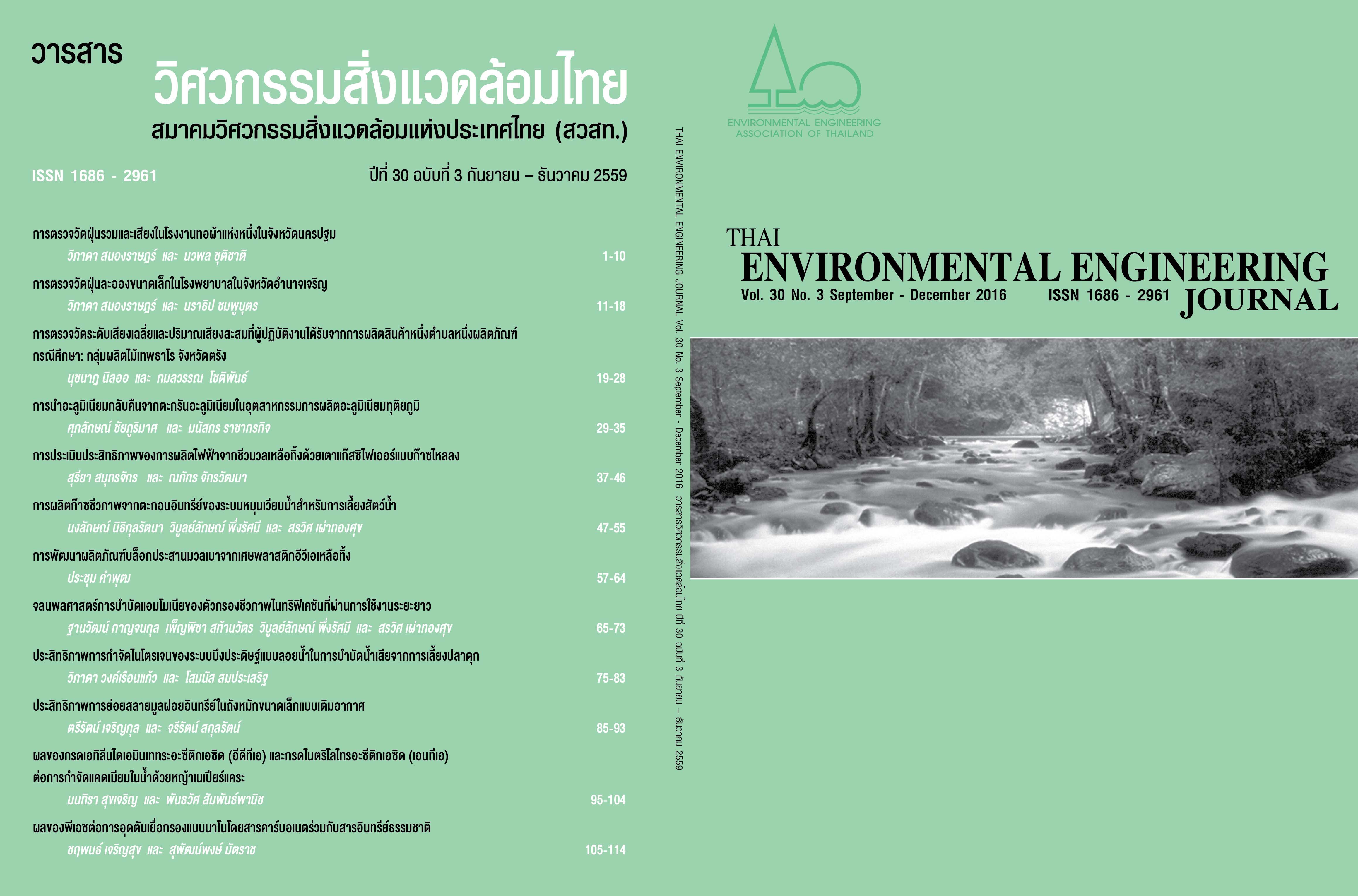Effect of pH on Nanofiltration Fouling of Combined Carbonate Species and Natural Organic Matter
Main Article Content
Abstract
Nanofiltration is an efficient system for removing inorganic and organic compounds depending on solution types and solution chemistry. Therefore, this research studied the effect of pH during nanofiltration (NF) fouling of combined carbonate species and natural organic matter using crossflow nanofiltration (HL4040FN, GE water and process technology). Solution conditions were controlled with ionic strength of 0.01 M, NOM concentration of 10 mg/L and various solution pHs of pH 4.3 (H2CO3 equiv. pt.), 6.3 (pKa1), 8.3 (HCO3− equiv. pt.), 10.3 (pKa2) and 11.3 (CO32− equiv.pt). Different solution pHs could change carbonate species from carbonic acid (H2CO3) at pH 4.3, to monovalent bicarbonate (HCO3-) at pH 6.3, then form divalent carbonate (CO32- ) at high solution pHs of 11.3. The increase in solution pHs from 4.3, 6.3, 8.3, 10.3 and 11.3 resulted in decreases of permeate fluxes of 29.31, 27.38, 22.23, 21.90 and 19.71 L/m2/h (LMH), respectively. The removal efficiencies of NOM for the range of solution pHs were approximately 96-98%. The sodium carbonate rejections measured by conductivity increased with increasing solution pHs, possibly caused by repulsion charge effects between negatively charged NF membrane and negatively charged carbonate species. Carbonate salt can form bicarbonate ions with increased solution pHs from 4.3 to 10.3, while carbonate species can dominate with high solution pHs of 11.3.
Article Details
References
[2] Supatpong Mattaraj. 2007. Water Chemistry. Printing House Ubon Ratchathani University, Ubonratchathani. (in Thai)
[3] Bruggen, Bart Van der and Carlo Vandecasteele. 2003. Removal of pollutants from surface water and groundwater by nanofiltration: overview of possible applications in the drinking water industry. Environ Pollut. 122: 435-44.
[4] Conteras, A.E., Albert Kimb and Qilin lia. 2009. Combined fouling of nanofiltration membranes: Mechanisms and effect of organic matter. J Membrane Sci. 327: 87-95.
[5] Listiarini, K., Darren, D. S. and James, O. L. 2009. Organic fouling of nanofiltration membranes: Evaluating the effects of humic acid, calcium, alum coagulant and their combinations on the specific cake resistance. J Membrane Sci. 332: 56-62.
[6] Siddiqui, M., Amy, G.L., Ryan, J. and Odem, W. 2000. Membranes for the control of natural organic matter from surface waters. Water Res. 34: 3355-3370.
[7] Tu, S., Varadarajan, R. and Massoud, P. 2005. A pore diffusion transport model for forecasting the performance of membrane processes. J Membrane Sci. 265: 29-50.
[8] Vrouwenvelder, J. and et al. 2003. Tools for fouling diagnosis of NF and RO membranes and assessment of the fouling potential of feed water. Desalination. 157: 361-365.
[9] Vrijenhoek, E.M., Hong, S. and Elimelech, M. 2001. Influence of membrane surface properties on initial rate of colloidal fouling of reverse osmosis and nanofiltration membranes. J Membrane Sci. 188: 115-128.
[10] Jarusutthirak, C., Mattaraj, S. and Jiraratananon, R. 2007. Factors affecting nanofiltration performances in natural organic matter rejection and flux decline. Sep Purif Technol. 58: 68-75.
[11] Allgeier, S.C. and Summers, R.S. 1996. Evaluating NF for BDP control with the RBSMT. J AWWA. 87: 87-99.
[12] Mattaraj, S. and Kilduff, J. E. Effect of natural organic matter properties on nanofiltration fouling. RSID 4th. Proceeding of the forth Regional Symposium on Infrastructure Development in Civil Engineering, Bangkok, Thailand, on April 3-5, 2003.
[13] Kilduff, J.E., Mattaraj, S. and Pieracci, J.P., Belfort, G. 2000. Photochemical modification of polyether sulfone and sulfonated polysulfone nanofiltration membranes for control of fouling by natural organic matter. Desalination. 132: 133-142.
[14] Cho, J., Amy, G. and Pellegrino, J. 2000. Membrane Filtration of Natural Organic Matter: Comparison of Flux Decline, NOM Rejection, and Foulants During Filtration with Three UF Membranes. Desalination. 127: 283-298.


